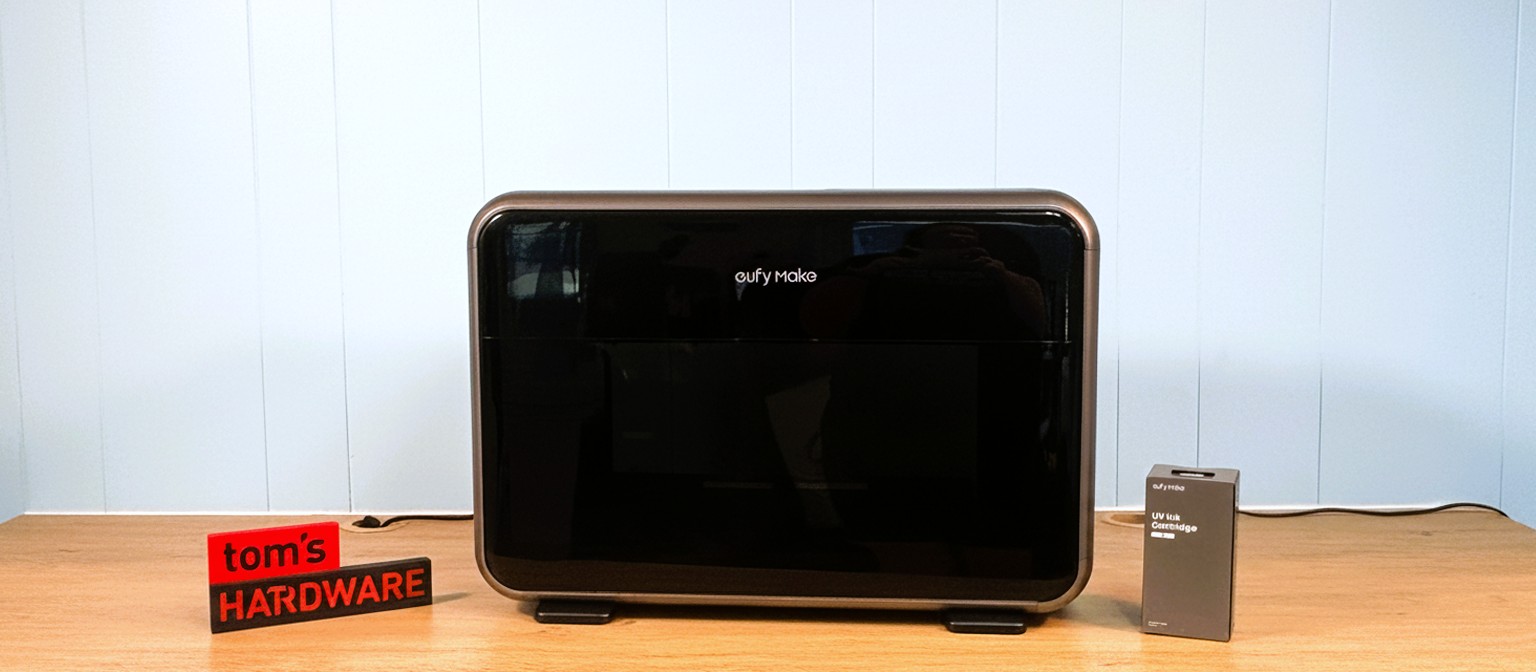Tom's Hardware Verdict
The EufyMake E1 is the latest piece of industrial high-tech to trickle down to the consumer market, with a hefty cost in ink and AI microtransactions. While it could be a new “must have” tool for makers, the current software still needs refinement.
Pros
- +
True full color printing
- +
Unique texture printing
- +
Prints on a variety of surfaces
Cons
- -
Costly
- -
Proprietary ink
- -
AI microtransactions
- -
UV ink smell
- -
Kickstarter
Why you can trust Tom's Hardware
The EufyMake E1 UV printer is not quite a 3D printer, but it’s close enough to raise interest from the crafty side of 3D printing. Imagine if a 2D photo printer had a baby with a resin 3D printer, and you might get an idea of the possibilities.
Like a paper printer, the E1 needs a surface to print on. Unlike a paper printer, that surface can be nearly anything that fits inside the chamber: paper, wood, metal, acrylic, most plastic, leather, or fabric.
Note: Fabrics require a special flexible ink that I didn’t get to test. It can also print on a special sticker material that will let you apply prints to items too large or odd-shaped to fit into the machine.
Its most exciting feature is the ability to “paint” images on flat surfaces, creating three-dimensional brush strokes, raised lettering, or raised portions of an image. This is rather like 3D printing, where dimensionality comes from stacking up many layers of material. Fortunately, it uses white ink or clear gloss (depending on the method you choose) to build that height, and it only needs a single layer of color. The color layer is mixed from four cartridges – Cyan, Magenta, Yellow, and Black. Ink is a bit spendy at $43 each for a non-refillable 100ml cartridge, or $300 for a full kit with cleaning fluid. I’ll get more in-depth on ink costs later in the review.
My biggest beef with EufyMake is the maintenance, which is entirely automated and mysterious. Because you cannot let the printhead or tubes dry out, EufyMake gives you two choices: either use it every day or let it go into maintenance mode. This sounds pleasant until you find out that a deep clean cycle will cost you $7 to $10 in various fluids and burn up 6 to 12 ml of ink. I can’t even give you a hard number because the software does not currently report precise ink levels. More on that later, too.
And yes, they’re very serious about preventing the machine from drying out. I broke the first beta unit sent for testing by “improperly” turning it off. In my defense, the machine lacks a vacation mode or any warning about what will happen if you turn it off for a couple of weeks without running a deep clean first. Hopefully, a vacation mode will be added in a future update. If you’re wondering why this review is being posted after the Kickstarter ended, it took several months to get a replacement machine and continue the review.
The EufyMake is the first printer of its kind for the consumer market, and had a record-breaking Kickstarter, with nearly 18,000 backers pledging over $46 million. Sadly, the E1 was scheduled to ship in July, but due to production issues, it is now shipping out in waves in November through December. This has left some bitter backers complaining on Facebook, so if you’re still on the fence about buying a retail unit, I would give this new machine another six months or so to find its footing.
Get Tom's Hardware's best news and in-depth reviews, straight to your inbox.
The other issue is EufyMake itself, which is AnkerMake flying under a new banner. AnkerMake brought us the AnkerMake M5 as a Kickstarter in 2022, and followed it up with a famously screen-free 3D printer, the M5C, in 2023. They failed to deliver the six-color upgrade promised to Kickstarter backers and, after “supply chain issues,” retreated from the 3D printing market altogether. I’m hoping the EufyMake E1 fares better and is given time to become a stable machine.
The EufyMake E1 currently starts at $2,299 for a basic setup with a set of ink cartridges. This is the “retail” version of the printer and will be shipped after the Kickstarter backers, with an expected ship date in February. This basic bundle comes with a regular and mini print bed and one round of ink. You’ll want to get the extra “White and Glossy” ink kit, as you will probably burn through quite a lot testing out the 3D features.
Specifications
Build Volume | 330 x 420 x 5mm (13 x 16.5 x .2 inches) |
Material | UV Ink |
Extruder Type | NA |
Nozzle | Propriety UV |
Build Platform | Sticky, disposable |
Bed Leveling | Automatic |
Filament Runout Sensor | NA |
Connectivity | Wi-Fi, App |
Interface | Button |
Machine Footprint | 590 x 250 x 407 mm (in) |
Machine Weight | 20kg (44 lbs) |
Price | 2299 |
Included in the box: EufyMake E1
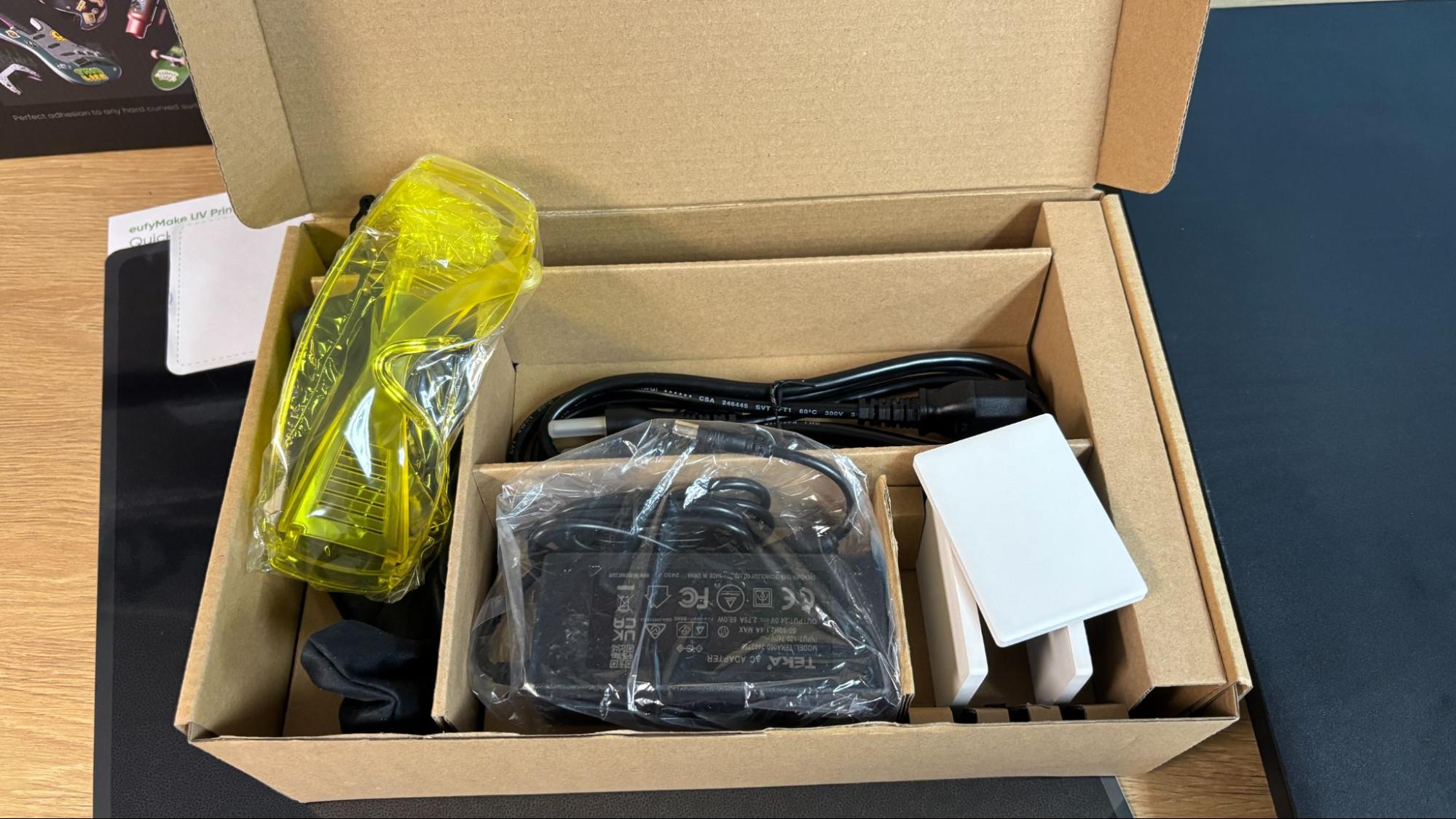

The EufyMake E1 comes with everything you need to set up your UV printer. The basic bundle comes with a full set of ink, a cleaning cartridge, an air filter, and two flatbeds with disposable sticky mats. One is the “mini” flatbed with a 90 x 330 mm print area (that fits inside the unit with the doors closed), and the other is a standard flatbed that covers the entire 330 x 420mm print area. A set of UV protective goggles is included for operating the machine with the doors open. The basic kit also includes three white ceramic magnets for testing.
Our test unit came with the laminator for making stickers, the rotary tool, and a sampling of EufyMake’s blank stock for printing on.
Assembling the EufyMake E1

The UV printer comes fully assembled. You only need to remove the packing material, then insert the filters (liquid cleaning tank and air filter) and the six ink tanks.
Calibrating the EufyMake E1

Calibrating the EufyMake E1 is done automatically at the initial start up. You will need to recalibrate the cameras whenever you swap from the mini to standard build platform.
Loading Ink in the EufyMake E1

The ink cartridges snap into the top of the machine. The software monitors ink levels and lets you know when one needs to be replaced.
Design of the EufyMake E1
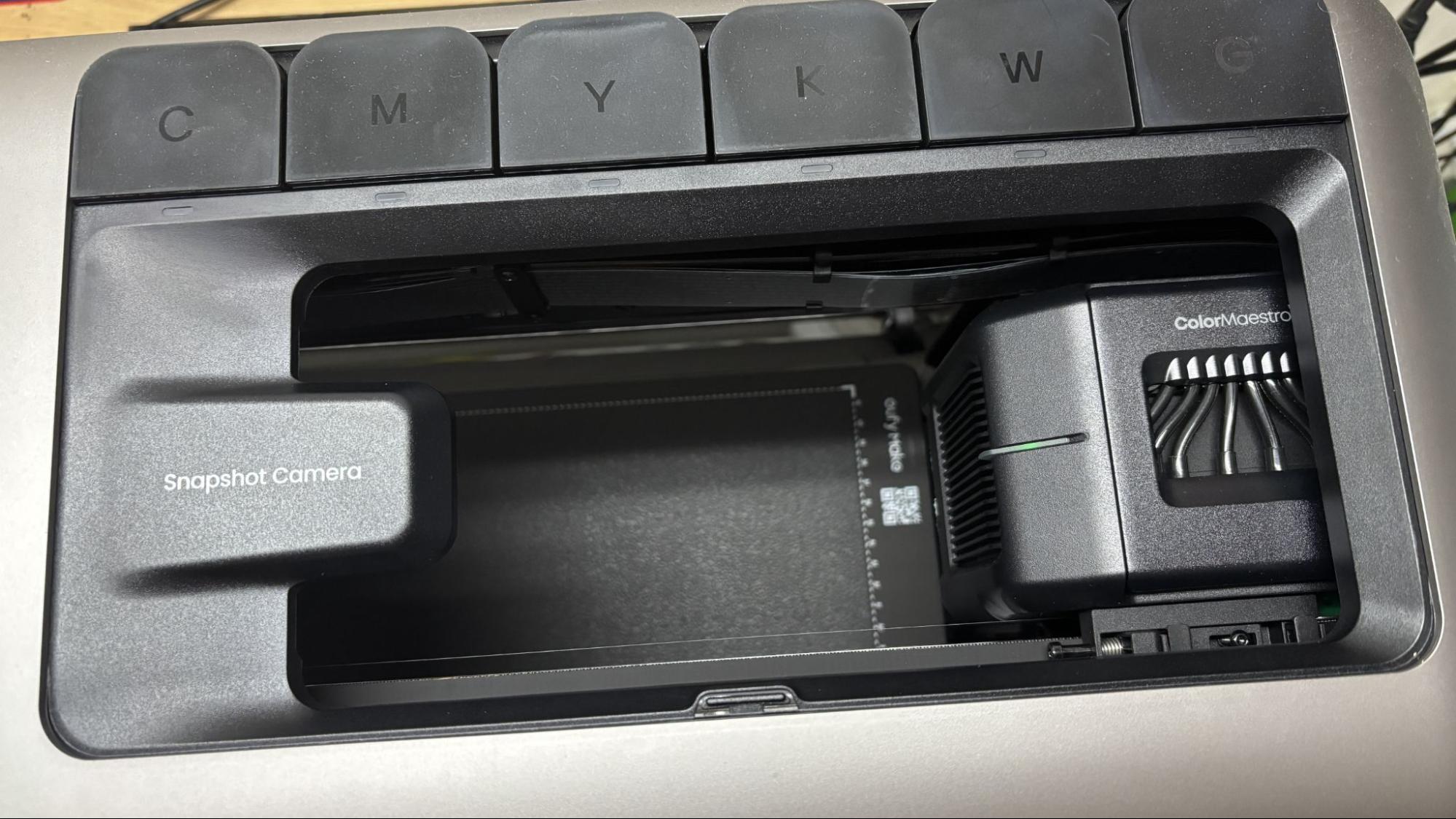
The EufyMake E1 is a sleek, modern-looking machine with a plastic case and translucent black doors that are hinged on the bottom for access to the interior. There are only two buttons on the machine, and no display screen. Everything is managed from the EufyMake app on a desktop or mobile device. One button is for power, and the other is a “start” button for safety.
The basic unit comes with two build platforms: one is slender and can be used with the doors closed, and the other is a larger one to hold canvases or many smaller items. EufyMake sells disposable sticky mats to protect the platform and hold your blank items. The overspray from printing UV ink edge to edge is impossible to remove, and since we don’t have pricing on replacement mats, beta testers have been covering the mats with tape, contact paper, or plastic wrap.
The E1 is monitored by two positioning lasers and a snapshot camera. The lasers measure the height and contours of the material you are printing on. The printhead must hover a few millimeters above the surface it’s printing on, so it can only handle items with a 5mm variance. You can get an optional rotary unit to print on curved surfaces, or print on a special clear sticker material that will let you transfer the print to anything that will hold a sticker.
The UV ink is a special material that cures instantly on the printhead when exposed to light. The curing process not only dries the ink but also helps it bond to the surface. The ink is hard after curing.
Ink comes in 100mL cartridges and is plugged into the top of the machine. There are four colors (cyan, magenta, yellow, and black) plus white and gloss. White can be used to prime a dark surface for clean color prints or to build up a 3D surface that is topped with color. The gloss can be used the same way, either to top the print with a super-shiny coating or to add a clear 3D effect.
There is also a JetClean cartridge with cleaning fluid that can be purchased as part of a kit or on its own. The system is set up so you never need to touch uncured ink.
Ink for the EufyMake is proprietary, which is to be expected for a first-of-its-kind machine. The cost of ink is one of the drawbacks of this machine, but over time, there may be 3rd-party alternatives. Right now, ink kits are priced at $300, which gives you a cleaning cartridge and six 100mL cartridges: CMYK, plus White and Gloss. Unless you only print on flat surfaces, you will burn through the white ink much faster than anything else. EufyMake also sells a pack of three white and three clear cartridges, plus a cleaning cartridge, for $300, or each cartridge individually for $43.
Prints are lined up using both the positioning lasers and a snapshot camera that takes a photo of your print bed and sends it to EufyMake studio. Accuracy is excellent, but it takes about 90 seconds to photograph the larger plate. You can skip this and use a “zero point” alignment system if you’re printing on plain, flat materials.
The EufyMake E1 comes with an air filter, which helps, but it should still be used in a well-ventilated room. I have the test unit on my resin printer counter, next to a ceiling vent, and it can still get a bit smelly while in use.
Preparing Files / Software for the EufyMake E1
The EufyMake E1 uses its own custom software, EufyMake Studio. This program has basic tools for creating artwork, assembling designs from clip art and adding AI assisted effects. It is also where you position your prints and send the files to the machine.
When you set up your account, you will be offered a basic free membership or the option to purchase a subscription with tokens to use with the “advanced” AI features. The free account has all the core design elements and 200 tokens for the AI. If you want to play with the AI features, you will want to get a LOT of tokens to start. There is no preview, so you will be charge each time you use the AI. Fortunately, you can save everything you make and print it later.
It’s not exactly clear what you’re getting with the AI, which often takes your photograph and turns it into a cartoon with depth. For example, one called “relief magnet” took an admittedly crappy snapshot of the Gateway Arch and turned it into a colorful cartoon. I rather like it, except it turned a tugboat and barge into a couple wooden fishing boats. It all made the Arch into a stone structure which is kinda weird. This cost me 10 tokens.

EufyMake Studio will also make your pets and favorite people into cartoons with 3D pop if you like. You can choose between Original, 3D Comic or Claymation. Here’s one of my dogs in 3D Comic and Claymation, which took a serious poodle and turned him into a rather angry mutt. This experiment cost 25 tokens, and I didn’t like any of them enough to print.
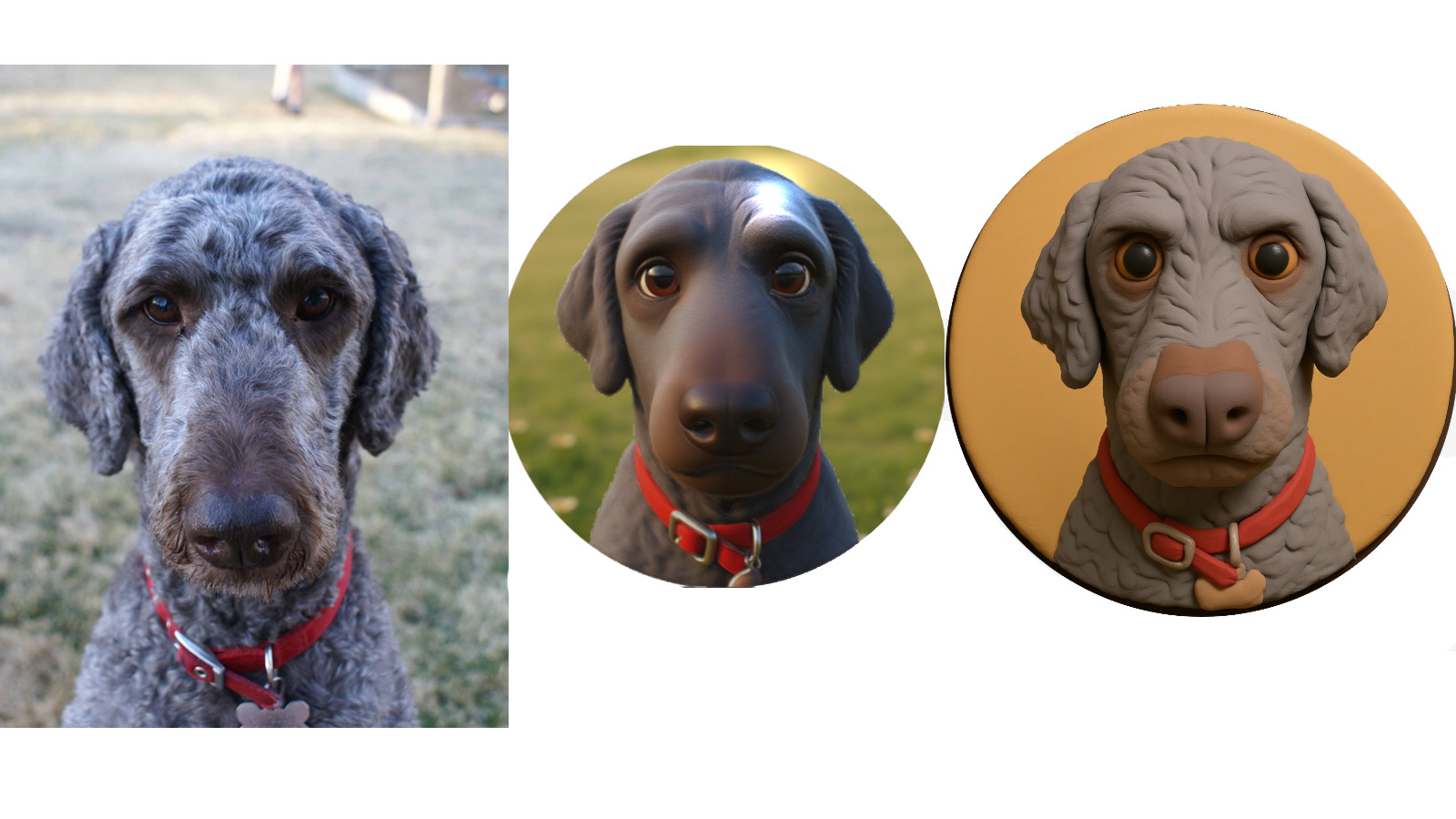
The Brushstroke AI tool is also interesting, and will take your photo and turn it into a painting with different styles. However, the results are extremely unpredictable, and you don’t know what you’re getting until you press generate. It would be helpful if the program showed both a before and after photo.
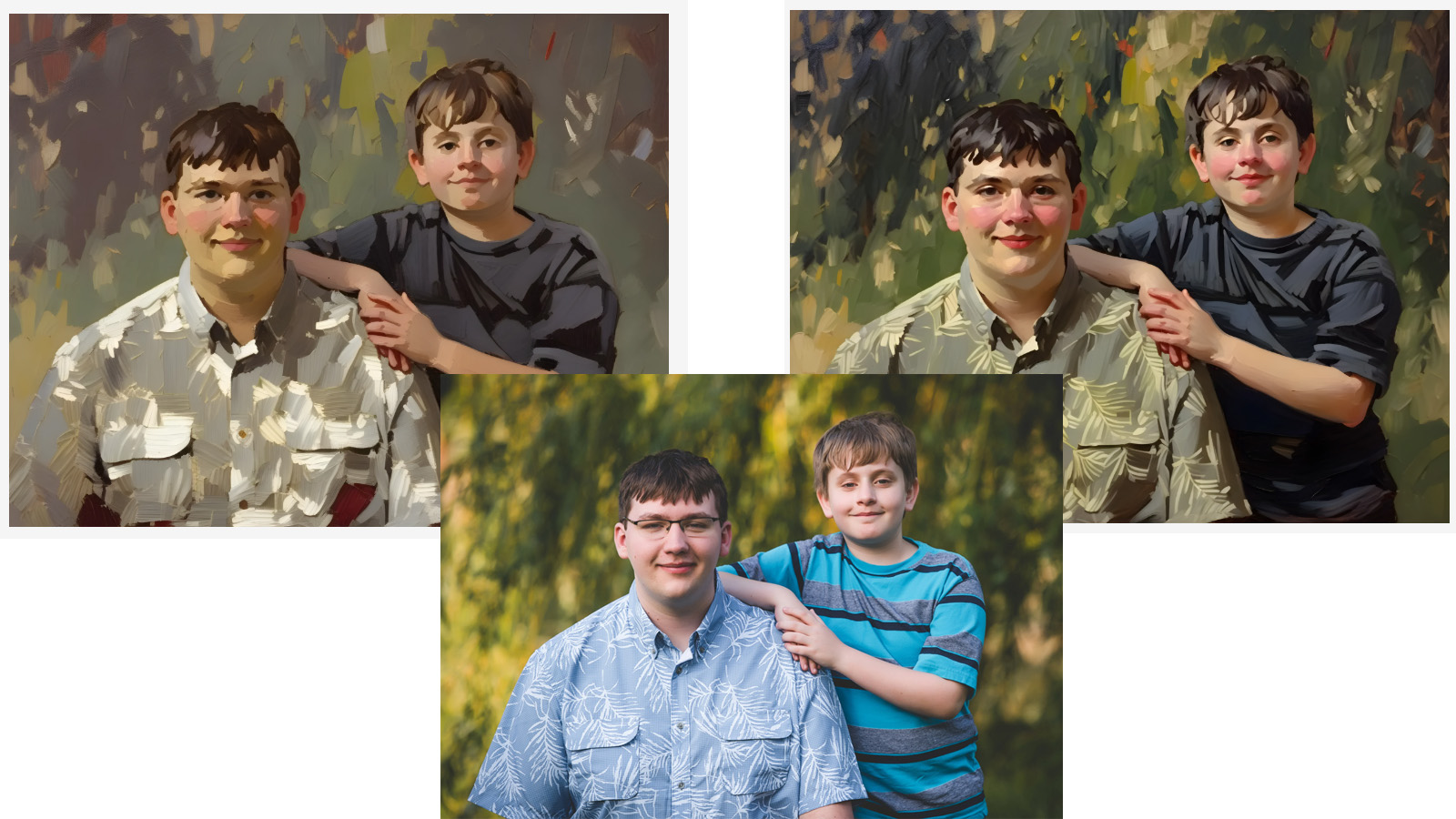
The AI tools do not let you clean up photos beforehand, so if you want to remove distracting backgrounds, you’ll want to do it first with other software.
Thankfully, you can get quite a lot from the free tools. Printing flat or raising the entire image is free. Creating a “pattern texture” where the AI simply raises portions of the image by contrast is free and looks very natural. You can also bring in your own custom depth maps created with 3rd party software.
A good example of a “free” pattern texture is taking an image, running it through Google’s AI studio and asking it to “recreate this image into a painting in the style of Van Gogh”. Import the image and ask EufyMake to use a pattern texture.
You can get a sense of what your print will look like in the software’s preview screen. The program runs a light across the image, which gives a decent representation of what the depth will really look like when printed. This dragon started out as a simple cartoon clip art from Canva, and was run through Google AI Studio with the “make it look like Van Gogh” instructions.
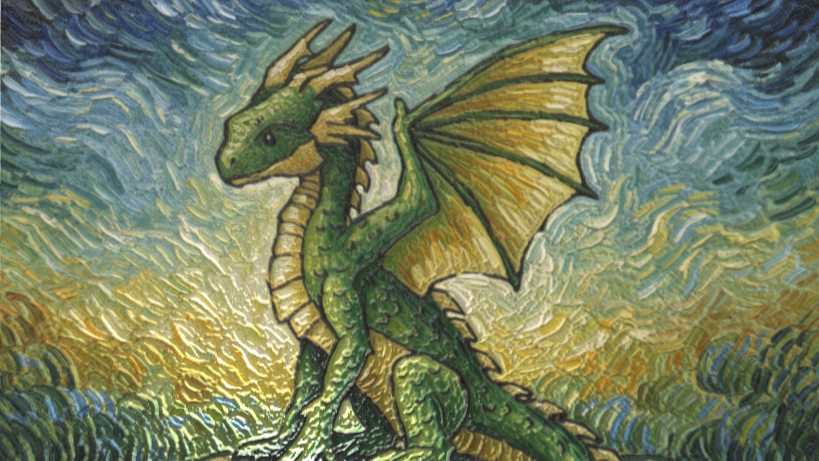
Printing on the EufyMake E1
The EufyMake E1 will come with a full set of CMYK ink, plus white and gloss. If you need to print on flexible materials, you’ll need to order a special “flexible” white ink.
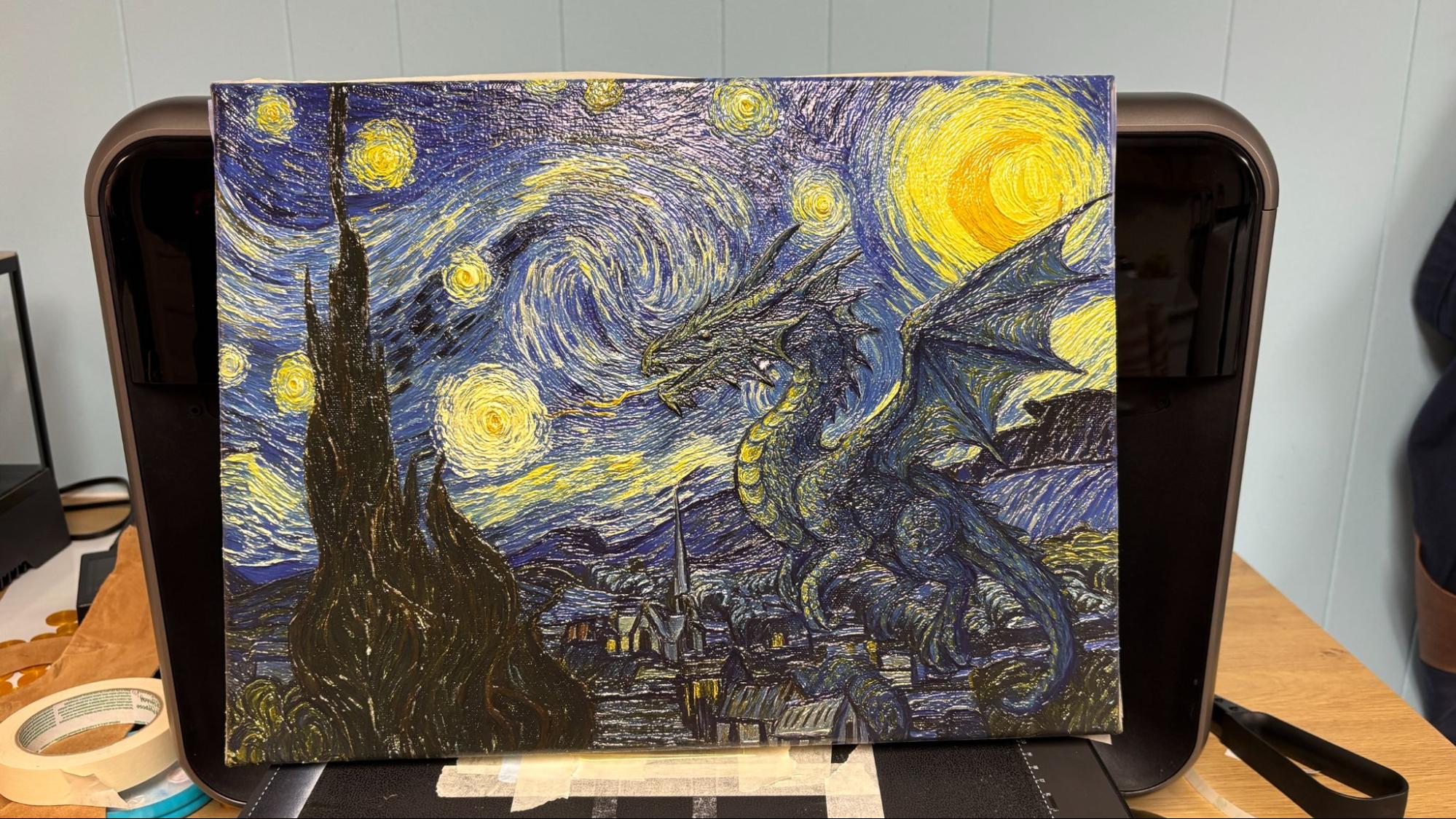
A good example of what the EufyMake can do is this faux painting on a 12 x 16-inch canvas. The art was made with ChatGPT, sampling Vincent Van Gogh’s Starry Night and a clip art dragon.

I maxed out the pattern texture setting with a 2mm height and got some really stunning results.

Because I brought in art that already had high contrast brush strokes, this didn’t cost any tokens to add the texture.
It used 46.27 mL of ink, of which 22.96mL was white and 22.16mL was gloss, which is nearly a quarter of each cartridge. CMYK cartridges didn’t even use half a mL each. This took 6 hours and 55 minutes to print. This piece cost $19.89 cents in ink, plus about $2 for the canvas. Sadly, the ink covers the canvas so well, you can’t really tell what it was printed on should you frame it.
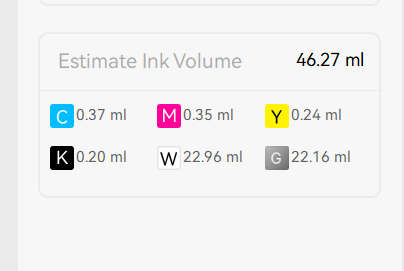
The UV ink is definitely tough. I used the EufyMake E1 to print side plates for my Death Racer, and took her through three battles at RMRRF, MMRF and 3D Printopia. The plates are printed in ASA and the UV print on top was a 2mm thick texture print. You can see that she took a good hit on the front corner, but the print only chipped a little. If anything, it added a bit of toughness.
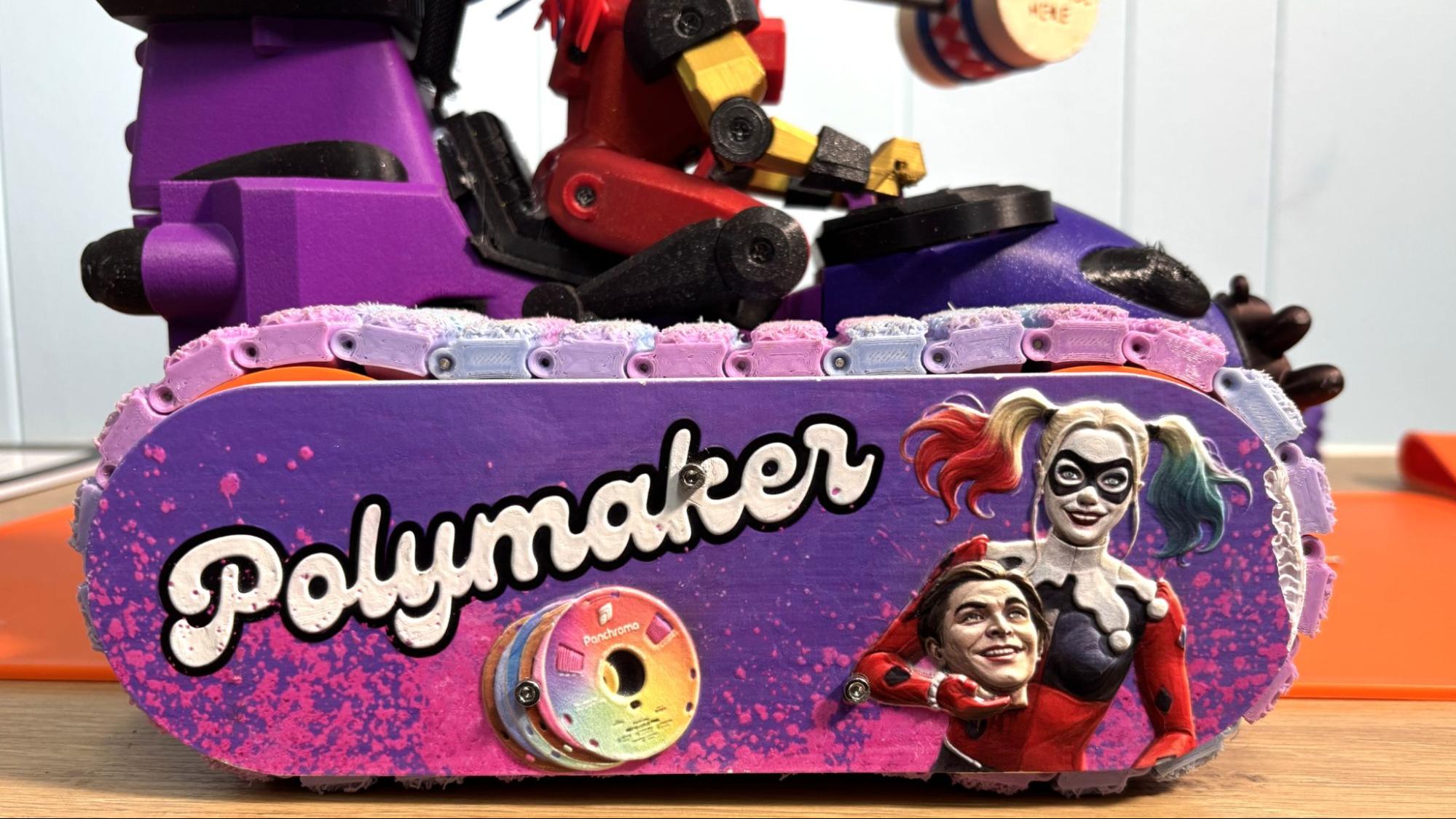
It’s not often that I get to show you the results from months of use, but the EufyMake is an odd exception. The first unit was from the early beta testing batch. I was able to get several prints, like the RC car and this phone case, before it had a terminal clog from an improper shutdown. This has been my everyday phone case for nearly five months. It has one scuff mark and some wear around the edges. The case underneath is a cheap Walmart plastic case that is somewhat flexible. The case took 4.5 mL of ink, with 2.26 mL in white and 2.18mL in gloss. It took an hour and 12 minutes to print, using a scant .4 mm raised pattern texture.

Bottom Line
The EufyMake E1 UV printer blurs the line between a traditional ink jet for 2D photos and a 3D resin printer. It's a fun-to-use creative tool for makers and craft fair vendors, has excellent quality, but lacks the speed and feasibility you need to run a true print shop.
The EufyMake E1 itself is not a bad price for a specialized printer. It’s currently priced at $2,299 for a basic setup with a set of ink cartridges. The color inks will last a long time, but the white and gloss are fleeting, as they are used to build up the layers. You’ll want to get the extra “White and Glossy” ink kit, since you can quickly burn through a cartridge of white ink doing a single full-sized “painting.” The price may improve if more companies get interested in UV printing for small businesses and crafters. HP is already in the market with a commercial printer, so anything is possible.
It can print on nearly anything. During testing, I only had trouble with thin PLA blanks warping, so I would suggest sticking to PETG or ASA if you want to create your own blanks or jigs.
If the EufyMake E1 is passed the Kickstarter phase, you can pre-order one now for $2,299 at EufyMake’s website. If the E1 has you thinking about getting into high-tech crafts, you might want to check out the xTool M1 Ultra, which can laser-cut and cut all manner of materials for $1,099. The Bambu Lab H2D is also a multipurpose craft machine and starts at $1,999 for the standalone unit, and up to $2,899 for a 3D printer laser combo.

Denise Bertacchi is a Contributing Writer for Tom’s Hardware US, covering 3D printing. Denise has been crafting with PCs since she discovered Print Shop had clip art on her Apple IIe. She loves reviewing 3D printers because she can mix all her passions: printing, photography, and writing.
-
ammiller789 Sounds like printing the texture is the biggest ongoing cost. How viable is it to 3d print the 5mm variance texture on FDM/resin, and then apply paint with the EufyMake? Presumably far more cost effective, right? Just without the convenience of a one shot. Thanks for the great review!Reply
